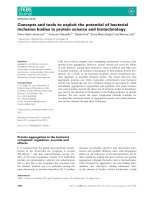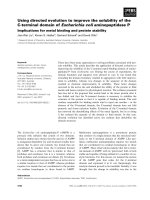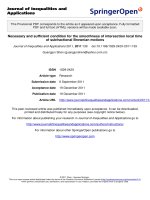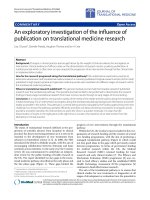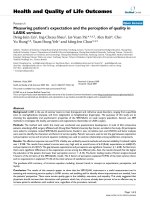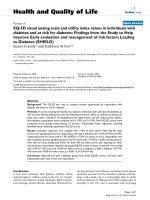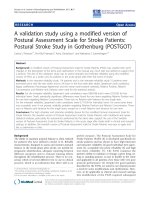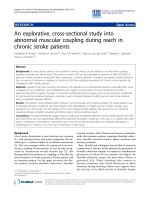báo cáo hóa học: " An exploratory study to evaluate the utility of an adapted Mother Generated Index (MGI) in assessment of postpartum quality of life in India" potx
Bạn đang xem bản rút gọn của tài liệu. Xem và tải ngay bản đầy đủ của tài liệu tại đây (224.56 KB, 10 trang )
BioMed Central
Page 1 of 10
(page number not for citation purposes)
Health and Quality of Life Outcomes
Open Access
Research
An exploratory study to evaluate the utility of an adapted Mother
Generated Index (MGI) in assessment of postpartum quality of life
in India
Jitender Nagpal
†1,2
, Rinku Sen Gupta Dhar
†3
, Swati Sinha
†3
,
Vijaylakshmi Bhargava
†3
, Aarti Sachdeva
†2
and Abhishek Bhartia*
2
Address:
1
Department of Pediatrics, Sitaram Bhartia Institute of Science and Research, B-16, Qutab Institutional Area, New Delhi 110 016, India,
2
Department of Clinical Epidemiology Sitaram Bhartia Institute of Science and Research, B-16, Qutab Institutional Area, New Delhi 110 016, India
and
3
Department of Gynecology and Obstetrics Sitaram Bhartia Institute of Science and Research, B-16, Qutab Institutional Area, New Delhi 110
016, India
Email: Jitender Nagpal - ; Rinku Sen Gupta Dhar - ;
Swati Sinha - ; Vijaylakshmi Bhargava - ;
Aarti Sachdeva - ; Abhishek Bhartia* -
* Corresponding author †Equal contributors
Abstract
Background: Given the postulated advantages of mother generated index (MGI) in incorporating
the patients' viewpoint and in the absence of a validated India specific postpartum quality of life
assessment tool we proposed to evaluate the utility of an adapted Mother-Generated-Index in
assessing postpartum quality of life (PQOL) in India.
Methods: The study was integrated into a community survey conducted in one district of Delhi
by two-stage cluster randomized sampling to recruit women who delivered in the last 6 months.
PQOL was assessed using MGI. Physical morbidity and Edinburgh- postnatal-depression-scale
(EPDS) were also recorded for validation purposes.
Results: All subjects (249 of 282 eligible) participating in the survey were approached for the MGI
evaluation which could be administered to 195 subjects due to inadequate comprehension or
refusal of consent. A trend towards lower scores in lower socioeconomic stratum was observed
(Primary index score-2.9, 3.7 and 4.0 in lower, middle and higher strata; Secondary Index Score-
2.6, 3.2 and 3.0 in lower, middle and higher strata). 59.4% mothers had scores suggestive of possible
depression (EPDS; n = 172). Primary index score had a good correlation with validator scores like
EPDS (p = 0.024) and number of physical problems (p = 0.022) while the secondary index score
was only associated with EPDS score (p = 0.020).
Conclusion: The study documents that the MGI, with its inherent advantages, is a potentially
useful tool for postpartum quality of life evaluation in India especially in the absence of an alternative
pre-validated tool.
Published: 2 December 2008
Health and Quality of Life Outcomes 2008, 6:107 doi:10.1186/1477-7525-6-107
Received: 12 August 2008
Accepted: 2 December 2008
This article is available from: />© 2008 Nagpal et al; licensee BioMed Central Ltd.
This is an Open Access article distributed under the terms of the Creative Commons Attribution License ( />),
which permits unrestricted use, distribution, and reproduction in any medium, provided the original work is properly cited.
Health and Quality of Life Outcomes 2008, 6:107 />Page 2 of 10
(page number not for citation purposes)
Background
The concept of quality of life (QOL) is complex and sub-
jective. Calman defines it as 'the extent to which hopes
and ambitions are matched by experience' [1]. In this con-
text the aim of medical care should be to narrow the gap
between a patient's hope and aspirations and what actu-
ally happens. Quality of life measurement methods have
been seen as an advance in health care outcomes assess-
ment [2]. However the questionnaire based structured
approaches have often been criticized for ignoring the
patient's viewpoint. Thus the 'Patient Generated Index'
was designed as a disease specific quality of life measure
which is self completed and patient centered [2]. The tool
requires minor modifications to be made disease or cul-
ture specific. It has the in-built advantage of allowing the
patient to decide the issues important to him/her allowing
applicability of the same questionnaire across socio-eco-
nomic and educational backgrounds. Mother Generated
Index (MGI) is one such modified form of the Patient
Generated Index designed for assessment of postnatal
quality of life [3]. Comprehensive evaluations of postna-
tal quality of life using the structured questionnaire [4]
and MGI [3] based approaches are available from devel-
oped countries. In the absence of a validated India specific
QOL tool some authors have attempted evaluation of
postnatal physical morbidity [5] while others have specif-
ically evaluated postpartum depression [6,7] but none
provide a comprehensive, standardized or comparable
quality of life evaluation. Given the wide social, cultural
and educational diversity in India we hypothesized that
MGI could be more useful than a structured questionnaire
in QOL evaluation in India and conducted this study to
explore utility in QOL evaluation in a community survey
in Delhi.
Methods
Semi structured interviews were conducted on 20 postpar-
tum mothers from the outpatient department of Sitaram
Bhartia Institute as a preparatory step prior to the survey.
These involved asking the mothers to identify the most
important positive and negative areas of their lives and to
rate their importance in the post partum period through
open ended questions. This was intended to study the
comprehensibility of the concept and to formulate a list of
areas perceived to be important. All interviews were video
recorded and reviewed. It was noted that all interviewed
women identified only 2 to 5 areas after much suggestions
and prodding by the counsellors. The women were noted
to have conceptual difficulty in identifying any areas or
aspects of life which were positively affected by the deliv-
ery. In light of the findings of the pilot study, existing lit-
erature on the subject was reviewed and it was decided to
adapt the index to the Indian setting, possibly at the
expense of limiting its comparability to other settings. In
an attempt to keep the index as simple as possible we
decided to follow the scoring and spending point specifi-
cations for patient generated index presented by Patel et al
[7]. In accordance with the same specifications it was
decided to restrict the number of areas identified to six, to
keep the scoring points at 10, to allow 12 spending points
and to allow the mother and child counselors to adminis-
ter the index if requested by the subject. To further sim-
plify the concept for administration we decided to allow
use of words like problems/areas/issues with the sug-
gested list (as most of the comments were negative or neu-
tral and this was judged to be easier to understand) and to
seek 'spending points' in terms of what they wanted to
improve the most.
This survey was conducted by two stage cluster ran-
domised sampling to recruit postpartum women who
delivered in the last 6 months. In stage 1, two colonies
each from 3 predefined strata based on MCD classifica-
tion of property tax – High (A, B), Middle (C, D) and Low
(E, F, G) were selected by simple random sampling [8]. In
stage 2, a sequential house-to-house survey was con-
ducted in each selected colony using one of four random
directions till all houses were linearly covered or a mini-
mum 50 subjects from the colony meeting the selection
criteria and willing to participate in the survey were iden-
tified. Details of the study design and sampling have been
reported earlier [9]. Selected subjects were then given a
date and time for questionnaire administration within 2
weeks of the initial visit. Women who delivered a live via-
ble newborn (after 28 weeks) in last 6 months were
included in the survey. Women to whom the survey ques-
tionnaire could not be administered (unable to commu-
nicate, seriously ill, physical/mental disability), women
with major illnesses- cardiac, renal, hepatic, intestinal,
neurological disease requiring continuing treatment or
has required hospital admission for > 1 week prior to
recruitment (within the last one year) and women who
had delivered outside Delhi were excluded. A detailed
written consent was sought from the subjects. No incen-
tives were given other than free test results of haemo-
globin, blood pressure, weight and height measurements
(data not presented). The project was approved by the
institutional ethics committee.
A standardized pretested questionnaire was administered
to the mother which included their age, obstetric history,
place and mode of delivery. The complete survey included
an assessment of the quality of delivery care services (data
not presented), cost of maternity care (data not presented)
and a third section on postpartum QOL. The question-
naire was translated into Hindi and back translated into
English to allow administration in either language. The
QOL section included three related parts. One included
the Mother Generated Index (see additional file 1), the
second included direct questions on acute and chronic
Health and Quality of Life Outcomes 2008, 6:107 />Page 3 of 10
(page number not for citation purposes)
postpartum physical problems (see additional file 2) and
the third section included the Edinburgh Postnatal
depression Scale (EPDS) (see additional file 3). Details of
profession, education and income were also recorded to
enable classification of socioeconomic status according to
the inflation adjusted (wholesale price index) Kup-
puswamy scale (KS) i.e high socioeconomic class (HSEC),
middle socioeconomic class (MSEC) and low socioeco-
nomic class (LSEC). A separate consent was sought before
administration of the QOL and depression related ques-
tions.
The Mother Generated Index is a single sheet three step
questionnaire. In step 1 the mother was asked to specify
up to five areas of her life that had been influenced/
affected by having had a baby. In addition a sixth row is
provided to represent all other aspects of life that are not
captured in the first five areas. In step 2, she was asked to
give herself a score out of 10 for each of these areas. The
average of these scores gave the primary index score (PIS)
(max = 10; lower PIS ~poorer quality of life). In step 3, she
was asked to allocate 12 spending points to improve any
one or more of these six areas of life. They were asked to
distribute these points in any manner they chose but
could not use more or less than 12 points. This was to see
the relative importance of potential improvement in the
six areas. The overall score also known as the secondary
index is calculated by taking weighted sum of each area as
specified in example in see additional file 4. The second-
ary index score (SIS) ranges from 0–10 where 0 reflects
that "reality most falls short of patients hopes and expec-
tations" and 10 is the "greatest extent to which reality
matches expectations".
Edinburgh postpartum depression scale is depression
screening tool with a ten question rating scale with four
choices per questions scored from 0 to 3. The maximum
possible score is 30 and subjects with a score of ≥ 13 are
considered to have likely depression while those with a
score of ≥ 10 are considered to have possible depression.
As specified EPDS is a screening tool and is not confirma-
tory. The tenth question on the scale classifies the fre-
quency of suicidal thoughts into 'Yes, Quite often,
Sometimes, Hardly ever and Never'.
Data entry and analysis was done using Epi-info2002 and
SPSS v 13.0. Complex samples procedure of the SPSS was
used to adjust the results for the two stage stratified cluster
design of the survey (inter and intra cluster variation).
Complex sample linear regression models were used to
study the relationship of baseline factors with the primary
and secondary index score.
Results
249 women were recruited (of 282 eligible subjects) from
5279 houses screened in the community. They were inter-
viewed by a mother and child educator between February
and April 2007. According to Kuppuswamy scale 77
women were categorized as HSEC, 43 women as MSEC
and 129 women as LSEC. All recruited women were
approached for the Mother Generated Index evaluation
but 43 women from LSEC, 7 women from the MSEC and
4 women from HSEC could not be administered the ques-
tionnaire. The reasons included refusal of consent, inabil-
ity to understand the questionnaire and reluctance to
discuss any problems. Thus data on MGI was available for
195 subjects (78.3%). There were no significant differ-
ences in demographic characteristics between participants
to whom MGI was administered compared with those to
whom it could not be administered. Ninety four subjects
were administered the questionnaire in Hindi while 101
were administered the questionnaire in English. No sig-
nificant differences were noted in the mean scores or the
areas identified by subjects administered the question-
naire in English or Hindi.
The socio-demographic profile of the subjects is presented
in Table 1. The average age of the subjects was 27.0 years
and 46.4% mothers were primiparous. Overall 34.6%
women had a cesarean section and the rate was 51.8%,
28.1% and 13.8% respectively in the high, middle and
low socioeconomic classes.
The average primary index score was 3.6 (3.3 to 3.9) while
the average secondary index score was 2.9 (2.4 to 3.4)
(Table 2). A trend towards lower quality of life scores in
lower socioeconomic strata was observed (Primary index
score HSEC-4.0, MSEC-3.7, LSEC-2.9 (2.5 to 3.4)), Sec-
ondary index score HSEC- 2.5, MSEC 2.8, LSEC- 2.0).
Difficulty in sleeping was the most frequently reported
concern in the HSEC and MSEC groups (66.8% (95%CI
49.6 to 80.4) and 64.7 (95%CI 43.7 to 81.3) respectively)
while tiredness and physical problems were most com-
monly reported by the LSEC (72.2% (95%CI 53.8 to 85.3)
and 66.9% (95%CI 39.7 to 86.1) respectively) (see addi-
tional file 5). In the HSEC, the lowest scores related to
emotional disturbances received the worst scores (Mean
Score = 2.9), physical problems and tiredness were scored
the worst in the MSEC (Mean Score = 2.6 and 2.8 respec-
tively) while weight related concerns, emotional distur-
bances and financial worries were scored the worst in the
LSEC (Mean Score = 0.6, 1.8 and 1.8 respectively). Sub-
jects from the high and middle income groups spent the
highest number of spending points on physical problems
(Mean spending points = 4.1) and weight related concerns
(Mean Spending Points = 3.8) while those from the lower
income groups spent most points on financial worries
(Mean spending Points = 4.0) (see additional file 5).
Physical problems (24.8%; Mean Score (MS) – 2.1; Mean
Spending Points (MSP) – 3.9), work related problems
(31.6%; MS – 2.3; MSP – 3.5), baby related concerns
Health and Quality of Life Outcomes 2008, 6:107 />Page 4 of 10
(page number not for citation purposes)
Table 1: Socio demographic profile of the population*
According to Socio-economic Class
Characteristics Overall(n = 195) HSEC (n = 73) MSEC (n = 36) LSEC (n = 86)
Age (years)
γ
27.0(25.8–28.2) 29.2(28.3–30.0) 25.1(23.5–26.6) 24.7(24.2–25.2)
Primi (%) 46.4 (36.2–56.8) 51.1 (34.5–67.5) 63.7 (48.3–76.8) 34.1 (30.3–38.2)
BMI(kg/m
2
)
γ
24.8(23.1–26.5) 27.0(25.2–28.8) 24.5(22.7–26.3) 21.9(20.3–23.6)
Education level (%)
γ
Illiterate/Primary school 15.8 (4.1–45.3) - - 42.5 (16.8–73.1)
Middle or High school 31.0 (18.1–47.6) 5.3 (0.3–48.1) 62.4 (30.9–86.0) 54.6 (25.0–81.3)
≥ College education 53.2 (31.7–73.6) 94.7 (51.9–99.7) 37.6 (14.0–69.1) 2.8 (1.7–4.7)
Gross monthly family income (Rs.)
γ
< 11,750 47.4 (23.9–72.2) 1.8 (0.6–5.7) 72.9 (42.9–90.6) 100 (0.0–100.0)
11,750–23,499 11.5 (3.7–30.7) 16.1 (5.1–40.5) 27.1 (9.4–57.1) -
23,500–50,000 8.9 (2.5–26.8) 17.8 (6.0–42.4) - -
>50,000 32.2 (17.1–52.1) 64.3 (36.6–84.9) - -
Current Employment Status
γ
(%)
Never worked 69.6 (49.9–84.1) 40.6 (30.8–51.3) 96.4 (60.2–99.8) 99.4 (92.0–100.0)
Working full time 8.3 (2.1–27.8) 16.7 (4.2–47.7) - -
Working part time 6.7 (2.9–14.7) 12.5 (5.9–24.5) 1.8 (0.1–23.9) 0.6 (0.0–8.0)
Not working at present 15.4 (6.1–33.7) 30.2 (16.5–48.6) 1.8 (0.1–23.9) -
Place of delivery
Hospital
ψ
79.0 (57.0–91.4) 80.9 (62.8–91.4) 88.3 (56.0–97.8) 73.2 (33.5–93.6)
Government 36.4 (28.8–44.7) 8.3 (2.0–29.0) 58.3 (53.2–63.2) 66.6 (34.5–88.3)
Private 42.6 (26.4–60.5) 72.6 (58.7–83.1) 30.0 (15.8–49.4) 6.6 (3.2–13.2)
Non- Institutional
π
12.2 (6.9–20.8) 17.7 (8.0–34.7) 9.9 (2.4–33.5) 5.7 (2.0–15.0)
Home 8.8 (1.3–42.0) 1.4 (0.1–18.4) 1.8 (0.1–23.9) 21.2 (4.6–60.0)
Mode of Delivery
CS 34.6 (19.7–53.3) 51.8 (41.0–62.4) 28.1 (11.6–54.0) 13.8 (4.8–33.5)
Elective CS 58.4 (35.9–78.0) 60.6 (36.7–80.3) 32.0 (2.7–88.9) 65.9 (37.9–86.0)
Emergency CS 41.6 (22.0–64.1) 39.4 (19.7–63.3) 68.0 (11.1–97.3) 34.1 (14.0–62.1)
Health and Quality of Life Outcomes 2008, 6:107 />Page 5 of 10
(page number not for citation purposes)
(6.2%; MS – 0.0; MSP- 5.0) and financial problems
(8.3%; MS- 1.2; MSP- 3.0) were rated the worst (mean
score < 3) and reported by significant proportion of moth-
ers (> 5%) of preterm babies (n = 25) compared with
physical problems (44.8%; MS-2.4; MSP-3.7) and emo-
tional disturbances (17.7%; MS-2.5; MSP-2.9) in mothers
of term babies (n = 170).
The EPDS could be administered to 172 mothers (of 195)
of which 59.4% mothers had a score of ≥ 10 (possible
depression), 10.9% mothers had suicidal thoughts and
36.6% mothers were suffering from likely depression
(defined as score ≥ 13). The incidence of possible depres-
sion [HSEC-44.9% (95%CI 30.5 to 60.2), MSEC-51.6%
(95%CI 22.1 to 80.1), LSEC-83.7% (95%CI 65.4 to
93.3)], likely depression [HSEC-27.7% (95%CI 22.0 to
34.3), MSEC-22.3% (95%CI 5.8 to 57.0), LSEC-54.4%
(95%CI 48.0 to 60.7)] and suicidal thoughts [HSEC-9.0%
(95%CI 5.1 to 15.3), MSEC-6.6% (95%CI 0.4 to 53.9),
LSEC-15.3% (95%CI 10.4 to 22.0)] was higher in the
lower socioeconomic classes.
As reported in Table 3 acute postpartum problems like
excessive bleeding were reported more often by the vagi-
nally delivered mothers (4.2% versus 1.0%). The chronic
postpartum problems like back pain, tiredness, and ina-
bility to do routine duties were reported more often by
abdominally delivered mothers. 94% of vaginally deliv-
ered mothers and 98.4% mothers in the cesarean group
reported no acute postpartum physical complication. The
postpartum problems were reported more often by prim-
iparous women (Table 4).
To further explore the utility of MGI we conducted a mul-
tivariate regression analysis with Primary and Secondary
Index Scores as the dependent variables [3] (Table 5). Pos-
sible confounders were identified by review of literature
(Mother's age [3], Parity [3], Mode of delivery [3], place of
delivery [3], maturity of newborn [4] and employment
status of mother [10]) and correlation analysis (No of
physical problems, KS Score, Body Mass Index (BMI),
EPDS Score). As depicted the number of physical prob-
lems and EPDS were significantly associated with the pri-
mary index score (p = 0.024 and p = 0.024 respectively)
after adjusting for co-variates while the EPDS score was
the only significant association of the secondary index
score (p = 0.020).
NVD with Perineum intact 17.9 (5.9–43.5) 1.4 (0.1–18.4) 4.5 (0.3–39.6) 44.7 (23.7–67.8)
NVD with epi 42.8 (36.9–49.0) 43.6 (37.3–50.1) 62.8 (40.9–80.5) 34.9 (20.3–53.0)
NVD with tear 0.9 (0.2–4.4) 0.7 (0.1–7.7) 1.8 (0.1–23.9) 0.9 (0.0–30.0)
Instrumental 3.7 (0.9–14.1) 2.5 (0.4–13.8) 2.7 (0.1–35.2) 5.7 (0.9–28.8)
*Data is presented as cluster adjusted mean (95% CI) or percentage (95% CI)
γ
These items reflects the status of the women at the time of conducting the survey
μ
Anemia was defined as Hb =< 11 gm%.
£
Any OPD or IPD medical reimbursement.
ψ
Hospital was defined as > 25 beds setup.
π
Non institutional delivery includes nursing home, private dispensary, government dispensary and individual practitioner home (clinic).
Table 1: Socio demographic profile of the population* (Continued)
Table 2: Post partum quality of life (MGI) and EPDS scores by socio economic class*
OVERALL (n = 195) HSEC (n = 73) MSEC (n = 36) LSEC (n = 86)
Primary Index
Score
(max = 10; n =
195)
3.6(3.3 to 3.9) Primary
Index Score
4.0(3.4 to 4.6) Primary
Index Score
3.7(3.1 to 4.3) Primary
Index Score
2.9(2.5 to 3.4)
Secondary
index Score
(max = 10; n =
195)
2.9(2.4 to 3.4) Secondary
index Score
3.0(2.4 to 3.7) Secondary
index Score
3.2(1.8 to 4.5) Secondary
index Score
2.6(1.9 to 3.3)
EPDS Score
(n = 172)
10.9
(9.7 to 12.0)
EPDS Score 9.5 (8.9 to 10.1) EPDS Score 9.3 (5.9 to 12.8) EPDS Score 13.4
(12.8 to 13.9)
*Data is presented as cluster adjusted mean (95% CI) or percentage (95% CI)
Health and Quality of Life Outcomes 2008, 6:107 />Page 6 of 10
(page number not for citation purposes)
Discussion
The study documents that the MGI is a potentially useful
tool for quality of life evaluation in post partum women
and especially so in the absence of a pre-validated ques-
tionnaire. The tool has good criterion validity (correlates
well with physical morbidity and validator scores like
EPDS), is comprehensive (able to provide information on
a wide range of potentially relevant issues) and allows
easy administration of general instructions in any lan-
guage. It has the inherent advantage of determining and
rating comments which are deemed important by the sub-
ject. However the MGI does not have the intrinsic capabil-
ity to test for internal reliability unlike structured
questionnaires. Also the tool has poor practicality or
Table 3: Distribution of post partum physical problems according to mode of delivery
α
Overall (n = 195) NVD (n = 136) CS(n = 59)
Acute Post Partum Physical Complications (%)
Inability to pass urine 0.2 (0.0–3.8) 0.4 (0.0–5.5) 0 (0)
Excessive bleeding 3.1 (1.7–5.5) 4.2 (2.0–8.8) 1.0 (0.1–12.1)
Need to remove placenta in OT or stitching in OT 0.6 (0.0–9.3) 0.9 (0.1–13.8) 0(0)
Others 0.6 (0.3–1.3) 0.5 (0.0–9.3) 0.7 (0.0–11.6)
No complication 95.5 (91.6–97.6) 94.0 (86.5–97.5) 98.4 (97.3–99.0)
Subacute/Chronic Post Partum Physical Problems (%)*
Painful Perineum
μ
5.3 (2.9–9.7) 8.1 (3.8–16.4) -
Fever 2.8 (0.2–27.8) 1.9 (0.1–27.3) 4.5 (0.5–32.5)
Infection from cut/torn perineum
π
(n = 100) 2.5 (0.6–9.3) 5.2 (1.4–17.8) -
Pain at the site of CS
γ
3.8 (0.9–14.9) - 10.9 (2.9–33.7)
Infection at the site CS
γ
0.6 (0.3–1.3) - 1.6 (1.0–2.7)
Urinary incontinence 0.2 (0.0–3.8) 0.4 (0.0–5.5) 0 (0)
Bowel Problems 4.1 (1.0–15.5) 3.9 (0.6–20.2) 4.4 (0.4–33.5)
Sore nipple/breast tenderness 4.0 (0.8–17.5) 5.3 (1.1–21.2) 1.7 (0.1–24.6)
Breast infection 2.0 (0.4–9.7) 2.8 (0.4–15.8) 0.7 (0.0–11.6)
Physical Exhaustion, tiredness 5.0 (2.4–10.1) 2.8 (1.0–7.3) 9.2 (3.1–24.2)
Back pain 8.2 (3.1–20.0) 3.9 (1.4–10.1) 16.3 (4.5–44.5)
Painful Intercourse
δ
(n = 92) 2.2 (0.1–30.5) 3.7 (0.2–41.7) 0 (0)
Inability to do routine duties 4.3 (0.8–19.6) 3.6 (0.8–15.2) 5.5 (0.7–31.7)
Relation with partner 1.4 (0.1–11.5) 0 (0) 4.0 (0.5–25.8)
α
Data is presented as cluster adjusted mean (95% CI) or percentage (95% CI)
*Reported as a "major problem for more than 7 days" in %
μ
Subjects who had a vaginal delivery
π
Subjects who had episiotomy or suturing of tear
γ
Subjects who had a cesarean section
δ
Subjects who had resumed sexual relations since the birth of the baby
Health and Quality of Life Outcomes 2008, 6:107 />Page 7 of 10
(page number not for citation purposes)
applicability in the LSEC as the tool could not be com-
pleted successfully by a substantial proportion of subjects
(33.8%) from the LSEC.
This is the first study evaluating post partum quality of life
in India using a standardized, comprehensive and replica-
ble index while documenting the limitations of the
method used. However, the study is limited by the poor
ability of the subjects from the LSEC to complete the ques-
tionnaire. The original mother generated index was mod-
ified in the context of the problems observed in the pilot
study limiting the comparability of the results to other set-
Table 4: Distribution of post partum physical problems according to parity
α
Primi (n = 92) Multi (n = 103)
Acute Post Partum Physical Complications (%)
Inability to pass urine 0 (0) 0.4(0.0–6.6)
Excessive bleeding 2.7(0.6–10.9) 3.5(2.6–4.6)
Need to remove placenta in OT or stitching in OT 1.3(0.1–17.1) 0(0)
Others 0.7(0.0–10.3) 0.4(0.0–6.6)
No complication 95.3(82.4–98.9) 95.7(91.5–97.8)
Subacute/Chronic Post Partum Physical Problems (%)*
Painful Perineum
μ
(n = 136) 17.0 (8.9–30.0) 0.9 (0.0–16.4)
Fever 2.6 (0.1–36.4) 2.9 (0.3–23.9)
Infection from cut/torn perineum
π
(n = 100) 2.3 (0.2–19.6) 8.6 (1.3–39.8)
Pain at the site of CS
γ
(n = 59) 18.2 (5.6–45.4) 3.9 (0.2–42.3)
Infection at the site CS
γ
(n = 59) 0 (0) 3.2 (1.6–6.4)
Urinary incontinence 0.5 (0.0–8.3) 0 (0)
Bowel Problems 7.5 (2.3–21.8) 1.1 (0.1–17.6)
Sore nipple/breast tenderness 8.7 (1.7–33.9) 0 (0)
Breast infection 3.9 (0.6–21.5) 0.4 (0.0–6.6)
Physical Exhaustion, tiredness 9.4 (3.7–21.9) 1.3 (0.1–17.6)
Back pain 10.9 (3.9–26.6) 5.9 (1.7–18.0)
Painful Intercourse
δ
(n = 92) 4.7 (0.3–47.8) 0 (0)
Inability to do routine duties 9.2 (1.5–39.5) 0 (0)
Relation with partner 0.7 (0.0–10.3) 1.9 (0.1–26.4)
α
Data is presented as cluster adjusted mean (95% CI) or percentage (95% CI) taking into account South Delhi's demographics
*Reported as a "major problem for more than 7 days" in %
μ
Subjects who had a vaginal delivery
π
Subjects who had episiotomy or suturing of tear
γ
Subjects who had a cesarean section
δ
Subjects who had resumed sexual relations since the birth of the baby
Health and Quality of Life Outcomes 2008, 6:107 />Page 8 of 10
(page number not for citation purposes)
tings. The primarily negative nature of the comments
selected using the pilot study, although necessitated by
the conceptual difficulties faced, could be expected to
result in lower overall quality of life scores. Also, the study
was conducted in one district of a big metropolis limiting
the generalizability of the results. Despite the limitations
the study provides useful information on the possible util-
ity of the concept in the Indian setting and identifies
important issues faced by the mothers in the post partum
period.
Several authors from developed countries have evaluated
post partum quality of life using structured questionnaires
[11,4] and MGI based approaches [3]. The character and
Table 5: Regression analysis: Statistical correlates of Mother Generated Index
α
Primary Index score Secondary Index score
Univariate (n = 195) Multivariate
ω
(n = 172)
§
Univariate (n = 195) Multivariate
ψ
(n = 172)
§
β-value p-value β-value p-value β-value p-value β-value p-value
Mother's Age 0.070
(-0.072–0.213)
0.241 0.028
(-0.096–0.151)
0.567 0.037
(-0.091–0.164)
0.471 0.030
(-0.078–0.139)
0.481
No. of Physical
problems
-0.127
(-0.202–0.051)
0.010 -0.150
(-0.267–0.033)
0.024 -0.146
(-0.342–0.050)
0.107 -0.164
(-0.382–0.054)
0.104
Primi/Multi -0.135
(-0.408–0.139)
0.243 -0.054
(-0.667–0.558)
0.818 -0.334
(-0.705–0.038)
0.067 -0.054
(-0.817–0.709)
0.854
BMI 0.077
(0.012–0.142)
0.030 0.022
(-0.059–0.103)
0.496 0.073
(0.002–0.144)
0.047 0.064
(-0.038–0.165)
0.157
KS Score* 0.056
(0.006–0.106)
0.036 0.049
(-0.026–0.123)
0.143 0.014
(-0.049–0.077)
0.574 -0.009
(-0.163–0.146)
0.884
EPDS Score
¶
-0.074
(-0.121–0.027)
0.012 -0.055
(-0.098–0.012)
0.024 -0.085(-0.150–
-0.020)
0.022 -0.090(-0.156–
-0.023)
0.020
Operative delivery
vs. others
β
0.337
(-0.611–1.286)
0.379 -0.060
(-0.554–0.435)
0.755 -0.130
(-1.288–1.029)
0.771 -0.371
(-1.448–0.706)
0.393
Hospital vs. Non
Institutional
π
0.127
(-0.459–0.714)
0.579 0.108
(-0.562–0.778)
0.678 -0.175
(-1.040–0.690)
0.604 -0.067
(-0.595–0.462)
0.744
Working vs. not
working
μ
0.261
(-0.769–1.291)
0.521 -0.465
(-1.179–0.249)
0.145 -0.276
(-1.874–1.322)
0.657 -0.331
(-2.966–2.303)
0.745
Premature babies
δ
0.608
(-1.500–2.717)
0.468 0.558
(-1.007–2.123)
0.378 0.351
(-1.816–2.519)
0.676 0.457
(-1.078–1.992)
0.455
Days Since Birth
γ
0.001
(-0.004–0.006)
0.599 0.000
(-0.002–0.001)
0.607 -0.001
(-0.009–0.007)
0.741 2.99E
(-0.005–0.005)
0.999
ω
R
2
= 0.197 (Model: Primary Index score = Mother's Age + total number of physical problems + parity + Body Mass Index + Kuppuswamy
socioeconomic class score + Edinburgh Postnatal depression Scale score + Operative delivery vs. others + Hospital vs. Non Institutional + Working
vs. not working + premature babies + Days since birth)
α
Data is presented as cluster adjusted mean difference in total MGI score(95% CI)
ψ
R
2
= 0.148 (Model: Secondary Index score = Mother's Age + total number of physical problems + parity + Body Mass Index + Kuppuswamy
socioeconomic class score + Edinburgh Postnatal depression Scale score + Operative delivery vs. others + Hospital vs. Non Institutional + Working
vs. not working + premature babies + Days since birth)
§
For 23 subjects EPDS could not be filled due to refusal of consent. *Kuppuswamy socioeconomic class score (Continuous variable)
¶
Edinburgh Postnatal depression Scale score (Continuous variable)
β
Cesarean Section vs. Vaginal delivery (Including NVD, NVD with Episiotomy, Forceps Delivery, Vacuum Delivery)
π
Hospital vs. Non Institutional delivery (includes nursing home, government health center and individual practitioner clinic).
μ
Presently working mothers vs not working
δ
Preterm babies (defined as < 37 weeks) vs term
γ
Time elapsed since birth at the time of questionnaire administration rounded of to the nearest day.
Health and Quality of Life Outcomes 2008, 6:107 />Page 9 of 10
(page number not for citation purposes)
expanse of the information provided by the MGI is com-
parable or better than that reported for structured ques-
tionnaires like Maternal Postpartum Quality of Life
(MAPP-QOL) [4]. The overall quality of life scores in our
study were lower than those reported in other populations
using either the MGI or structured questionnaire
approach. In a study on 184 women using MAPP-QOL,
Hill et al [4] reported that women who have delivered a
term infant give the worst scores to the Health and Func-
tioning domain as compared with worst scores for Emo-
tional concerns in mothers who had a preterm child. The
mean overall and domain specific scores in this study
were much higher than those from our study (20.8/30
compared with 3.6/10 in our study). In our study physical
problems, work related concerns, baby related concerns
and financial problems were poorly rated and reported by
a significant proportion of the mothers (> 5%) of preterm
babies compared with physical problems emotional dis-
turbances in mothers of term babies. In a study in the US
on 132 women comparing pre and postnatal physical,
mental and self rated quality of life scores, significant
deterioration was noted in the domains of vitality (p =
0.031), sleep (p = 0.009) and self rated quality of life (p
=< 0.001) from the pre to the post natal period [11].
Scores in the domains of general health, vitality, mental
health and self-rated quality of life were generally higher
than those reported in our study.
Symon AG et al [3] using MGI on 103 women reported
that 'tiredness', 'less time to themselves' and 'time with
family members' were the most common comments cited
by the mothers at 6–8 weeks post partum. In another
study by the same author the overall mean primary index
score was 4.8/10 in unemployed and 6.3/10 in working
mothers [10] compared with 3.5/10 in unemployed
mothers and 3.8/10 in working mothers in our study.
As discussed earlier, the overall lower scores in our study
could be related to the primarily negative nature of the
areas identified in the pilot survey or could reflect a poorer
quality of life our subjects. Although it is difficult to be
certain on the issue the overall paucity of positive areas
identified by the mothers in the pilot study and the subse-
quently lower overall quality of life ratings during the sur-
vey, coupled with the ratings on physical morbidity and
EPDS scores do suggest that post partum quality of life in
the given population is poorer than that reported in liter-
ature from developed countries.
Conclusion
Postnatal quality of life data from India is scanty and
given the absence of a validated structured questionnaire
the mother generated index provides a useful and possibly
advantageous alternative. The index offers inherent
advantages by incorporating the patients' viewpoint,
largely avoiding the need for linguistic validation and
potentially allowing comparisons across the disparate cul-
tural and lingual heterogeneity of Indian states and across
the world. The overall low scores in the current study need
confirmation in a wider variety of settings but nonetheless
highlight the need for integration of quality of life impact
into clinical outcome evaluations in the future especially
in developing countries like India where it is often
ignored. The possibility of further optimizing the index
for the Indian population by reducing the number of
items asked deserves exploration. Further work is also nec-
essary to study the correlation of MGI with ethnicity and
other validator scores like Post-natal Morbidity Index
[PNMI; 12] and Maternal Adjustments and Maternal Atti-
tude [MAMA; 13] scale.
Abbreviations
MGI: Mother-Generated-Index; PQOL: Postpartum Qual-
ity of Life; EPDS: Edinburgh-postnatal-depression-scale;
QOL: Quality of Life; KS: KuppuswamyScale; HSEC: High
Socioeconomic Class; MSEC: Middle Socioeconomic
Class; LSEC: Low Socioeconomic Class; PIS: Primary
Index Score; SIS: Secondary Index Score; BMI: Body Mass
Index; MAPP-QOL: Maternal Postpartum Quality of Life;
PNMI: Post-natal Morbidity Index; MAMA: Maternal
Adjustments and Maternal Attitude.
Competing interests
The authors declare that they have no competing interests.
Authors' contributions
AB conceived the idea for the survey. JN, RS and SS
planned the survey design and supervised the data collec-
tion. AS collected the data with the help of a research
team. Data was analyzed by JN and AS. RS, SS and AS
drafted the manuscript. All authors contributed to the
final version of the manuscript. VLB will act as guarantor
for the paper.
Additional material
Additional file 1
Mother Generated Index. The mother generated index proforma with the
suggestion list and method of scoring.
Click here for file
[ />7525-6-107-S1.doc]
Additional file 2
Postpartum physical problems. It includes direct questions on acute and
chronic postpartum physical problems.
Click here for file
[ />7525-6-107-S2.doc]
Publish with Bio Med Central and every
scientist can read your work free of charge
"BioMed Central will be the most significant development for
disseminating the results of biomedical research in our lifetime."
Sir Paul Nurse, Cancer Research UK
Your research papers will be:
available free of charge to the entire biomedical community
peer reviewed and published immediately upon acceptance
cited in PubMed and archived on PubMed Central
yours — you keep the copyright
Submit your manuscript here:
/>BioMedcentral
Health and Quality of Life Outcomes 2008, 6:107 />Page 10 of 10
(page number not for citation purposes)
Acknowledgements
The study was supported by intramural funding from Sitaram Bhartia Insti-
tute of Science and Research. The authors acknowledge the invaluable input
provided by Dr Kavita Arora, Consultant Psychiatrist, Sitaram Bhartia Insti-
tute of Science and Research.
References
1. Calman KC: Quality of life in cancer patients–an hypothesis. J
Med Ethics 1984, 10:124-127.
2. Tully MP, Cantrill JA: The validity of the modified patient gen-
erated index–a quantitative and qualitative approach. Qual
Life Res 2000, 9:509-520.
3. Symon A, MacDonald A, Ruta D: Postnatal quality of life assess-
ment: introducing the mother-generated index. Birth 2002,
29:40-46.
4. Hill PD, Aldag JC: Maternal perceived quality of life following
childbirth. J Obstet Gynecol Neonatal Nurs 2007, 36:328-334.
5. Chabra S, Shivkumar PV, Bhalla R: Quality of postpartum care.
Journal of Obstetrics and Gynaecology of India 2006, 56:142-145.
6. Chandran M, Tharyan P, Muliyil J, Abraham S: Post-partum depres-
sion in a cohort of women from a rural area of Tamil Nadu,
India. Br J Psychiatry 2002, 181:499-504.
7. Patel V, DeSouza N, Rodrigues M: Postnatal depression and
infant growth and development in low income countries: a
cohort study from Goa, India. Arch Dis Child 2003, 88:34-37.
8. Colony wise list according to MCD classification of property
tax [
]
9. Dhar Sengupta R, Nagpal J, Sinha S, Bhargava VL, Sachdeva A, Bhartia
A: Direct Cost of Maternity Care Services in South Delhi: A
Community Survey. Journal of Health, Population & Nutrition in
press.
10. Symon A, McGreavey J, Picken C: Postnatal quality of life assess-
ment: validation of the Mother-Generated Index. BJOG 2003,
110:865-868.
11. Gjerdingen DK, Center BA: First-time parents' prenatal to post-
partum changes in health, and the relation of postpartum
health to work and partner characteristics. J Am Board Fam
Pract 2003, 16:304-311.
12. Glazener CM, Abdalla M, Stroud P, Naji S, Templeton A, Russell IT:
Postnatal maternal morbidity: extent, causes, prevention
and treatment. Br J Obstet Gynaecol 1995, 102:282-287.
13. Kumar R, Robson KM, Smith AM: Development of a self-admin-
istered questionnaire to measure maternal adjustment and
maternal attitudes during pregnancy and after delivery. J Psy-
chosom Res 1984, 28:43-51.
Additional file 3
Edinburgh Postnatal depression Scale (EPDS). The EPDS question-
naire and scoring
Click here for file
[ />7525-6-107-S3.doc]
Additional file 4
Example. An example demonstrating how to calculate the primary index
score and secondary index score
Click here for file
[ />7525-6-107-S4.doc]
Additional file 5
Table. MGI scores (Mean (95% CI), spending points (Mean (95% CI)
and most common comments of participants (Percentage (95% CI)
according to socioeconomic class
Click here for file
[ />7525-6-107-S5.doc]
